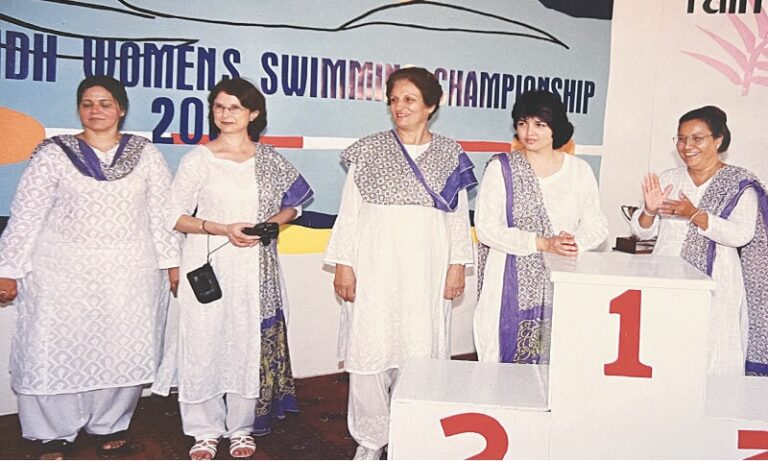In the late 1980s, a young Shaan Kandawalla made her mark in Pakistan swimming scene by sneaking into a men’s race at Karachi’s exclusive Sind Club. At that time, women had no space to swim competitively, and Shaan, though only a teenager, was determined to change that. While she broke many records and won numerous gold medals over the years, her biggest achievement wasn’t the medals but the fight she led for women to finally have a chance to compete in swimming events.
Fast forward three decades, and women’s athletes are no longer struggling to simply participate—they are now fighting for the best gear, such as the latest $500 Speedo Fastskin LZR swimsuit. The Women’s Sindh Open, now in its 30th edition, is a significant milestone that speaks to the dedication and persistence of women swimmers in Pakistan. But how did they get here?
The Role of Mothers in Creating Opportunity
Shaan recalls training for hours in the overly chlorinated waters of the Sind Club pool. She often trained alongside Kamal Masud, a national swimming prodigy, whose mother Veena watched from the poolside. Shaan couldn’t help but envy Kamal’s opportunities, but she knew the person who could make a difference for women in Pakistan—Veena Masud.
It wasn’t easy, but after a bit of persuasion, Veena agreed that women deserved their own swimming competitions. She reached out to other mothers, like Nargis Rahimatoola, Fatima Lakhani, and others, many of whom had daughters who also swam. Together, these women formed the Karachi Women’s Amateur Swimming Association (KWASA) in 1992, with the goal of creating a space for women swimmers in Pakistan.
The First Women’s Sindh Open
In 1992, the first Women’s Sindh Open took place at Karachi Club. For many swimmers, it was a surreal experience. Some swam in leotards instead of swimsuits, while others could barely finish a lap. Many wore sanitary pads because tampons were considered taboo. Despite the challenges, the event was a major breakthrough—it was the first time women had their own swimming competition in Pakistan.
At that time, the country was still under the influence of General Ziaul Haq’s regime, which imposed strict rules about women’s participation in sports. Women’s swimming competitions were allowed, but only if they followed certain religious guidelines. No male spectators or officials were allowed, and the athletes had to wear knee-length swimsuits. Media coverage was also banned.
To make the event more successful, Fatima and Ronak Lakhani sought out sponsorship from Colgate-Palmolive, which agreed to sponsor the Sindh Open starting in 1994. This helped elevate the event, giving it a more professional feel with medals, trophies, and other prizes.
The Growth of Women’s Swimming in Pakistan
As the Sindh Open grew in popularity, so did the level of competition. The Karachi Parsi Institute (KPI) became a key venue for training and competitions. Many of the top swimmers, including Shaan, Nadia, and Julia Irani, trained here and contributed to Sindh’s success at national championships.
In 1997, Pakistan’s women swimmers had a major breakthrough when they competed at the 2nd Women’s Islamic Games in Tehran. These games, organized by Faezeh Hashemi (daughter of Iran’s president at the time), provided an opportunity for women athletes from conservative Muslim countries to compete internationally. Although the games were not held in Pakistan due to logistical issues, they marked a significant step forward for women’s swimming in the region.
However, Shaan’s dream of competing in the 1996 Atlanta Olympics was crushed by strict regulations against women swimming in front of a mixed-gender audience. Instead, Kamal Masud represented Pakistan at the Olympics, becoming the first swimmer from the country to compete in the event. Shaan, however, was proud of the progress made by women’s swimming in Pakistan, even if she did not get to compete herself.
The Women Behind KWASA
KWASA’s early success can be attributed to the hard work and dedication of a group of mothers who volunteered their time to ensure the success of women’s swimming in Pakistan. Veena Masud, in particular, was a driving force behind the organization. She not only helped organize competitions but also mentored the younger generation of swimmers. Other women, like Fatima, Ronak, and Sumbul, played crucial roles in managing events and providing support to the swimmers.
In the years that followed, the Sindh Open continued to grow, with more categories and longer events introduced to match the increasing skill levels of the swimmers. What started as a small competition for women became a vital part of the swimming community in Pakistan.
The Challenges Ahead
Despite the progress, women’s swimming in Pakistan still faces many challenges. The sport has been plagued by poor governance, corruption, and a lack of interest from the government. Kiran Khan, a national champion, says that the future of swimming in Pakistan looks bleak unless the government provides more support for athletes.
In recent years, sports in Pakistan have become more fragmented due to a shift from federal to provincial responsibility. Training camps and international coaching programs, once funded by the government, have been discontinued. Now, many athletes must rely on their own resources and the support of their families to pursue their dreams.
Sum Up
The story of women’s swimming in Pakistan is one of struggle, perseverance, and triumph. From Shaan Kandawalla sneaking into a men’s race in the 1980s to the 30th edition of the Sindh Open today, these women have fought tirelessly for the chance to compete. While there is still much to be done, their achievements have opened doors for future generations of female athletes in Pakistan.


